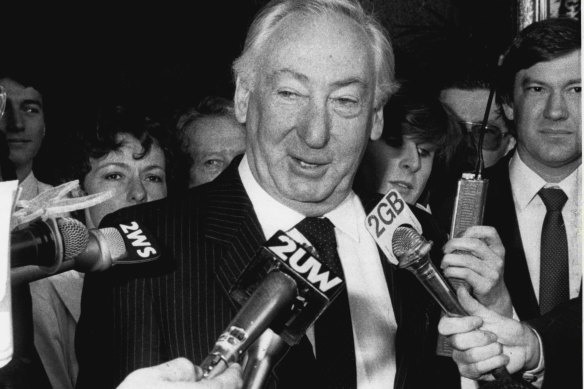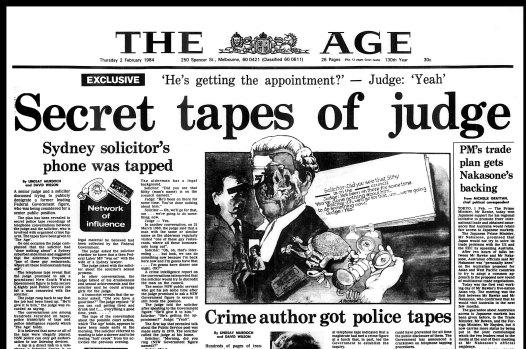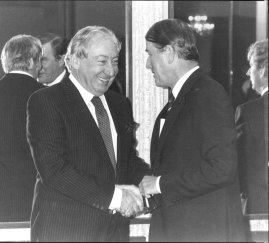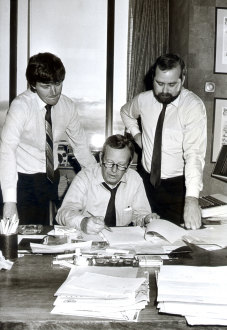- Tony Wright’s Column
- National
- High Court of Australia
This was published 1 year ago
Anatomy of a scandal: A top judge, secret police tapes and reporters under fire
By Tony Wright
“It was a late-night telephone call that is every journalist’s dream,” Lindsay Murdoch recalls.
It was a tip-off about illegally bugged telephone discussions containing evidence of all manner of criminal activity, cover-ups and intrigue among the bent and the powerful.

High Court judge Lionel Murphy in 1985.Credit: The Age
Some of the bugged conversations brought into question the integrity – never satisfactorily resolved – of no less than a High Court judge who had previously been Australia’s attorney-general in the Whitlam government, Lionel Murphy.
The first front-page story following the late-night tip-off appeared under the headline “Secret tapes of judge”.
“A senior judge and a solicitor discussed trying to denigrate a former leading Federal Government figure who was being considered for a senior public position,” the first paragraph declared.
It was February 2, 1984 – exactly 40 years ago this week.
It was the genesis of what became known as The Age Tapes – a series of investigative reports in the mid-1980s concerning a web of influence at the highest levels of Australia’s political and legal systems.
A huge blow-up of the first front page of The Age Tapes series still hangs on a wall of The Age’s office in Melbourne, reminding young journalists of part of a long history of investigative journalism – almost always furiously contested by the powerful – that continues today.
The “clippings file” of The Age Tapes is among the largest in the newspaper’s library, many of the reports carrying the bylines of Lindsay Murdoch – who later became a long-time foreign correspondent for The Age and is now retired – and the then head of The Age’s investigative unit, the late David Wilson.
It took only days for Lionel Murphy to be named under parliamentary privilege as “the senior judge”, causing all hell to break loose.
The solicitor was Morgan Ryan, who acted for Sydney’s leading crime figure, Abe Saffron, among others.

The front page of The Age on February 2, 1984.Credit: The Age
Ryan was known as “The Fixer” for his apparent ability to strike secret deals that got his clients, including major drug dealers, lenient sentences in the courts of certain magistrates. Famously, Murphy allegedly called Ryan “my little mate”.
Police had been illegally tapping Ryan’s phone for evidence concerning his or his clients’ involvement in the operation of illegal casinos, starting-price bookmaking, drug dealing and other criminal activity.
The High Court judge was unwittingly dragged into the scandal when his phone calls to the solicitor and their discussions about judicial and political appointments were swept up in the bugging.
Murphy was something of a hero among Labor supporters and progressives but was considered a dangerous radical by some conservatives. As Whitlam’s attorney-general, he had introduced no-fault divorce, abolished the death penalty for federal crimes and introduced legal aid, among other reforms.

Murphy with NSW premier Neville Wran in 1984.Credit: Philip Wayne Lock
But after The Age Tapes hit the newsstands, and the stories kept coming, Murphy faced two parliamentary inquiries looking at whether he had tried to influence members of the judiciary for the benefit of his “little mate”, the dodgy Morgan Ryan, followed by two criminal trials for allegedly perverting the course of justice.
The first trial found him guilty and the High Court judge was sentenced to 18 months’ jail. He successfully appealed and was acquitted at a second trial.
Murphy was being investigated by yet another parliamentary inquiry – this time to determine whether he was a fit and proper person to continue to sit on the High Court – when he revealed he was dying of cancer.
The government of Bob Hawke put an end to the inquiry, and Murphy died in October 1986, having returned, controversially and briefly, to the bench.
The story behind the story remains, 40 years later, a high-stakes study of how journalists at the time operated in their attempts to shine light into dark places – in this case, via a huge trove of transcripts of conversations taped illegally by NSW Police during the late 1970s and early 1980s.
The transcripts, and several actual tape recordings, were brought to The Age by Bob Bottom, a journalist and author who was the nation’s leading investigative reporter.
The NSW police who entrusted the material to Bottom clearly did not trust their own police hierarchy or the NSW political system of the early 1980s. In turn, Bottom felt himself in danger.
Many of the taped calls had nothing to do with Lionel Murphy or Morgan Ryan, but related to the activities of some of Australia’s most dangerous criminals, from Mafia boss Bob Trimbole to crooked police to hitman Christopher Dale Flannery, known as “Mr Rent-a-Kill”.
“I could tell from Bottom’s voice when I picked up the telephone at my home in North Fitzroy on Saturday, January 21, 1984, that he was in trouble,” Murdoch remembers.
“A few weeks earlier in Sydney, I had heard from journalist and political sources that a campaign was under way to discredit Bottom because of what he knew about a network of influence that pervaded NSW politics at the time.
“ ‘If anything happens, come and see us at The Age,’ I told Bottom over beers in a city bar.”
Within weeks, Bottom made his late-night call. He had learnt police were preparing to raid his home, and said the then NSW premier, Neville Wran, was desperate to stop him publishing evidence of the “network of influence”.
“Bottom told me during that telephone call he was in possession of explosive tapes and transcripts of telephone tapping operations illegally carried out by NSW police and that he had been told by sources the government of then NSW premier Neville Wran was desperate to stop him publishing them,” Murdoch says.
‘If you stuff this up we may as well all take a walk to the end of the jetty and jump in.’
Robert Haupt, then acting editor of The Age
Bottom had been tipped off that the NSW government was set to make it an offence to be knowingly in possession of transcripts or other records of illegal telephone taps, with penalties of five years’ jail and/or fines of up to $50,000.
“I suggested that he get on a plane to Melbourne as soon as he could,” Murdoch says.
Murdoch, The Age’s David Wilson and the then acting editor of The Age, Robert Haupt, booked Bottom into a suite at Melbourne’s Windsor Hotel, where the material in Bottom’s possession would be outside NSW jurisdiction.
At the Windsor, Bottom opened suitcases containing 524 pages of transcripts and police reports covering 3980 tapped conversations, along with actual cassettes recording 11 conversations.
“Wilson and I knew as soon as we started reading the material we were on to the biggest story of our careers,” says Murdoch. “When we briefed Haupt on what we had, he told us to be meticulous in verifying the material and to take as long as we needed to prepare our stories.
“He told us, ‘If you stuff this up we may as well all take a walk to the end of the jetty and jump in because it will end our careers.’ ”
Indeed, many politicians and lawyers declared the publication of the tapes was a serious invasion of privacy and violation of the human rights of those whose conversations were secretly recorded.
The Age’s editor at the time, Creighton Burns, however, staunchly defended the publication and was named Australian journalist of the year for doing so.

Age editor Creighton Burns flanked by reporters David Wilson (left) and Lindsay Murdoch.Credit: The Age
When Neville Wran described the material as “phoney”, Burns sent Haupt and Murdoch to Sydney to deliver copies to his government.
“When we handed them to then NSW attorney-general Paul Landa in his office, he tossed the package in the bin and turned away without saying a word,” Murdoch says.
Gareth Evans, a long-time defender of civil liberties, was one of the most articulate critics.
Although he specified five areas of possible breaches of federal laws revealed in the tapes and ordered an inquiry, Evans told the Senate that The Age had “outraged privacy and threatened basic human rights”. The investigation of crime was not a matter for “amateur sleuths” pursuing a “salacious press story” or asking “muck-raking questions”.
Murdoch recalls that during telephone call at the height of the backlash. “Evans described me as an inconsequential nobody parading around town as ‘Bernstein of the Age’ and [Creighton] Burns as ‘the great Perry White’ and accused us of outrageously denigrating Murphy, whom he described as ‘one of the greatest Australians’.”
Bottom continued to work with Wilson and Murdoch in the investigative unit for several years after publication of The Age Tapes, receiving an extraordinary array of leaks, much of them relating to organised crime.
There was so much exclusive material leaked to the team that the editor had a secret office with storage racks fitted out on The Age’s editorial floor.
John Silvester lifts the lid on Australia’s criminal underworld. Subscribers can sign up to receive his Naked City newsletter every Thursday.